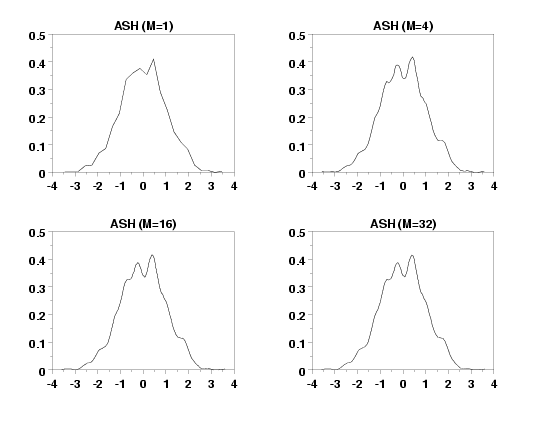AVERAGE SHIFTED HISTOGRAM
Name:
AVERAGE SHIFTED HISTOGRAM
Type:
Purpose:
Generates an average shifted histogram.
Description:
In addition to providing a convenient summary of a
univariate set of data, the histogram can also be thought
of as a simple kernel density estimator.
David Scott has proposed the average shifted histogram
(see chapter 5 of the "Multivariate Density Estimation: Theory
and Practice, and Visualization" listed in the Reference
section below) as a kernel density estimator that maintains
the computational simplicity of the histogram while providing
performance comparable to the more computationally intensive
kernel density plot (enter HELP KERNEL
DENSITY PLOT for details on the kernel density plot).
The basic algorithm for the average shifted histogram is:
- Choose a class width of h (in Dataplot, you can
select this class width with either the CLASS WIDTH or
the SET HISTOGRAM CLASS WIDTH command, otherwise a default
class width of 0.3 times the sample standard deviation
will be used).
- Choose m where we construct a collection of
m histograms, each with a class width of h,
but with start points t0 = 0,
h/m, 2h/m, ... ,
(m-1)h/m.
In Dataplot, the value of m is set by entering
the command
before entering the AVERAGE SHIFTED HISTOGRAM command.
If the number of points is less than or equal to 100,
the default value is 4. If the number of points is less
than or equal to 1,000, the default value is 8. If the
number of points is greater than 1,000, the default value
is 16.
Dataplot sets values of m < 1 to 1 and values of
m > 64 to 64.
- This results in a "smoothed" histogram with a bin width of
delta=h/m. Higher values of m
result in a smoother estimate. Values of m are
typically in the range 4 to 32.
This is the algorithm given on page 117 of Scott. This effectively
gives an isosceles triangle weighting function. Scott gives a
generalization of the ASH algorithm that gives a biweight weighting
function. This is the ASH1 algorithm on page 118. This will
generate a smoother curve with less local noise than the triangular
weighting.
To use this biweight weighting function, enter the command
SET AVERAGE SHIFTED HISTOGRAM WEIGHT BIWEIGHT
To restore the default triangular weighting, enter
SET AVERAGE SHIFTED HISTOGRAM WEIGHT TRIANGULAR
Syntax:
AVERAGE SHIFTED HISTOGRAM <x>
<SUBSET/EXCEPT/FOR qualification>
where <x> is the variable of raw data values;
and where the <SUBSET/EXCEPT/FOR qualification> is optional.
Examples:
AVERAGE SHIFTED HISTOGRAM TEMP
AVERAGE SHIFTED HISTOGRAM Y SUBSET TAG = 2
AVERAGE SHIFTED HISTOGRAM Y FOR I = 1 1 800
Note:
Dataplot implements average shifted histograms using
the algorithms BIN1 and ASH1 given on pages 117-118 of the
Scott book.
Note:
The average shifted histogram can be adapted to higher
dimensional data. It is this multivariate case where
the computational simplicity (relative to the kernel
density plot) is particularly attractive. At this time,
we have not implemented the multivariate case. We do
plan to implement it in a future release.
Note:
The AVERAGE SHIFTED HISTOGRAM command generates an estimate
of the underlying density function. You can convert this
to an estimate of the cumulative distribution function by
integrating the density estimate. The following shows an
example of doing this in Dataplot.
LET Y = NORMAL RANDOM NUMBERS FOR I = 1 1 1000
AVERAGE SHIFTED HISTOGRAM Y
LET YPDF = YPLOT
LET XPDF = XPLOT
LET YCDF = CUMULATIVE INTEGRAL YPDF XPDF
TITLE ESTIMATE OF UNDERLYING CUMULATIVE DISTRIBUTION
PLOT YCDF XPDF
You can also obtain an estimate of the percent point function
(inverse cdf) with the following additional commands:
LET YPPF = XCDF
LET XPPF = YCDF
Default:
Synonyms:
ASH is a synonym for the AVERAGE SHIFTED HISTOGRAM command.
Related Commands:
Reference:
David Scott (1992), "Multivariate Density Estimation,"
John Wiley, (chapter 5 in particular).
B. W. Silverman (1986), "Density Estimation for Statistics and
Data Analysis," Chapman & Hall.
Applications:
Implementation Date:
Program:
LET Y = NORMAL RANDOM NUMBERS FOR I = 1 1 1000
TITLE OFFSET 2
MULTIPLOT CORNER COORDINATES 0 0 100 100
MULTIPLOT SCALE FACTOR 2
MULTIPLOT 2 2
LET M = 1
TITLE ASH (M=1)
AVERAGE SHIFTED HISTOGRAM Y
LET M = 4
TITLE ASH (M=4)
AVERAGE SHIFTED HISTOGRAM Y
LET M = 16
TITLE ASH (M=16)
AVERAGE SHIFTED HISTOGRAM Y
LET M = 32
TITLE ASH (M=32)
AVERAGE SHIFTED HISTOGRAM Y
END OF MULTIPLOT

Date created: 12/05/2005
Last updated: 12/01/2023
Please email comments on this WWW page to
alan.heckert@nist.gov.
|
|


